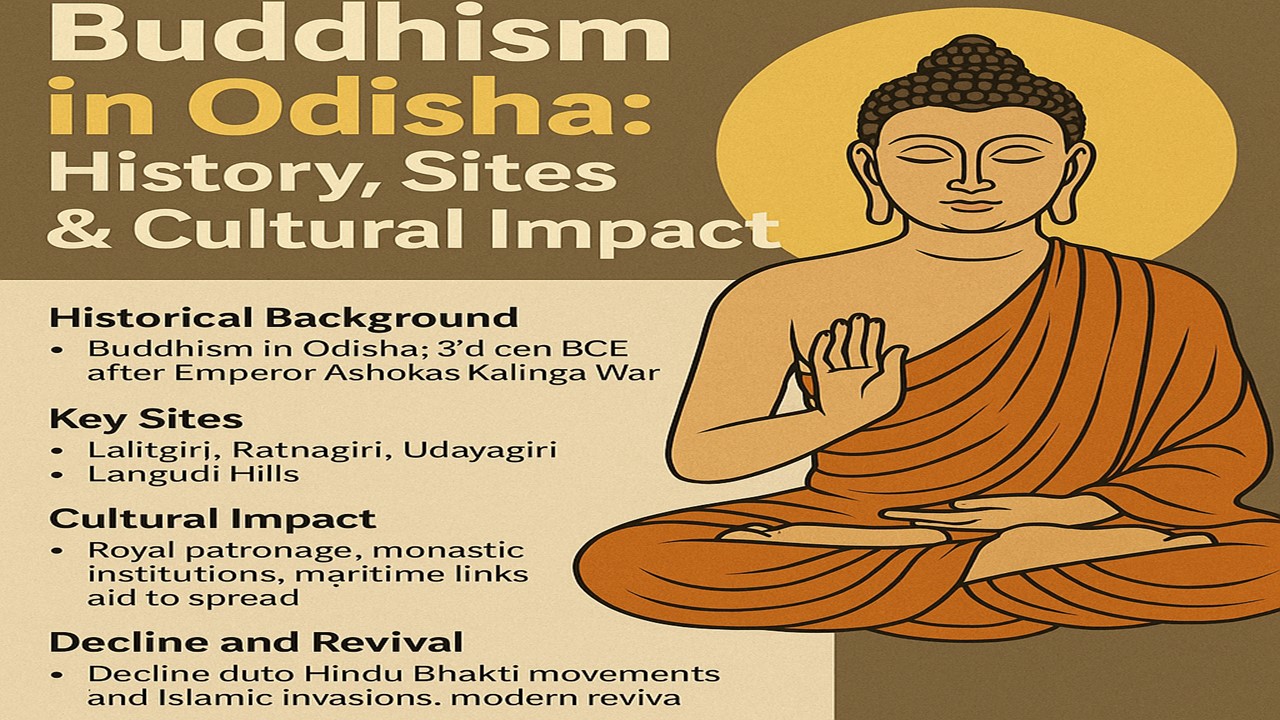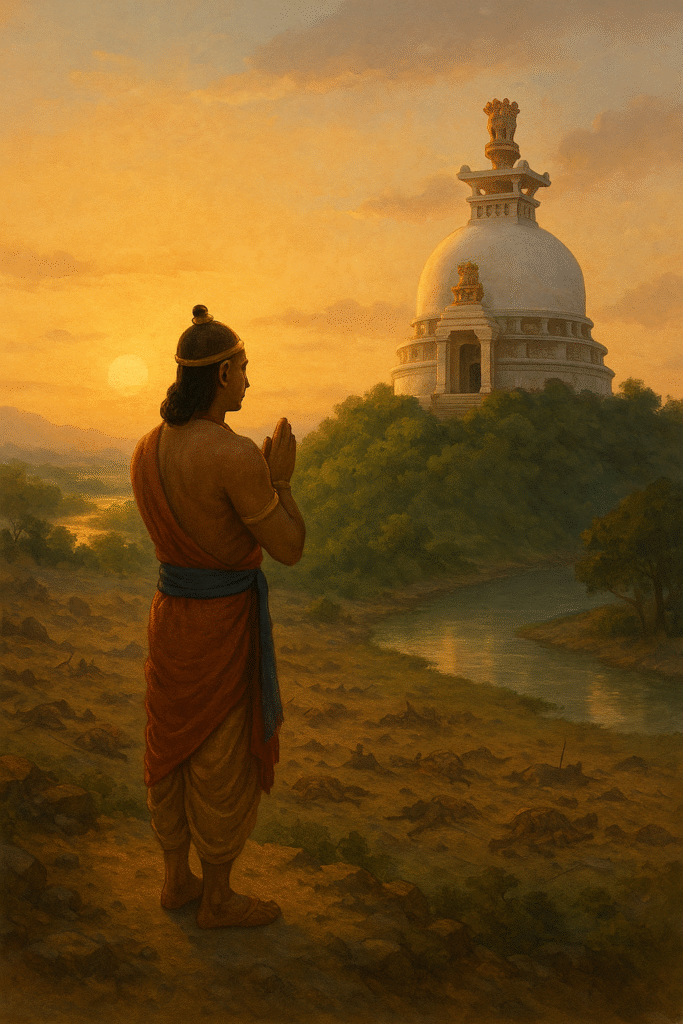
Growth of Buddhism in Odisha: History, Sites & Cultural Impact
Historical Background
Buddhism in Odisha (formerly Orissa) has a long and rich history, dating back to the 3rd century BCE, especially after the Kalinga War fought by Emperor Ashoka in 261 BCE. The devastating war changed Ashoka’s heart and led him to embrace Buddhism, making Odisha a central hub for its spread.
Growth of Buddhism in Odisha
- Impact of Kalinga War
- The brutal war deeply moved Ashoka.
- After converting to Buddhism, Ashoka actively promoted Buddhist values like ahimsa (non-violence) and dhamma (righteousness).
- Odisha (then Kalinga) became a major center for Buddhist learning and pilgrimage.
- Royal Patronage
- Mauryan, Shunga, and Gupta emperors supported Buddhism.
- Regional dynasties like the Kharavelas of Kalinga also promoted Buddhism.
- Kharavela’s Hathigumpha Inscription in Udayagiri confirms his support for Jainism and Buddhism.
- Monastic Institutions
- Establishment of monasteries and viharas in places like:
- Ratnagiri
- Lalitgiri
- Udayagiri
- These became prominent Mahāyāna and Vajrayāna Buddhist learning centers during the 5th–12th centuries.
- Establishment of monasteries and viharas in places like:
- Trade and Maritime Links
- Odisha had strong coastal and maritime trade with Southeast Asia.
- Buddhist monks and traders traveled, spreading Buddhism to Sri Lanka, Myanmar, Thailand, and Indonesia.
Important Buddhist Sites in Odisha
- Lalitgiri
- One of the oldest sites (1st century CE)
- Excavations revealed monasteries, stupas, and relics.
- A casket with relics believed to be of Buddha was found.
- Ratnagiri
- Flourished between the 5th to 13th centuries CE.
- Known for monastic complexes, sculptures, and Vajrayana practices.
- Udayagiri
- Hill complex with rock-cut caves and Buddhist sculptures.
- Served as a Buddhist university and training center.
- Langudi Hills
- Recently excavated site.
- Believed to be the seat of Puspagiri Mahavihara, an ancient Buddhist university.
Decline and Revival
- Buddhism declined after the 13th century due to:
- Rise of Hindu Bhakti movements.
- Islamic invasions.
- Loss of royal patronage.
- Modern Revival:
- Sites rediscovered during British rule and post-Independence.
- Government and international Buddhist organizations have promoted tourism and heritage conservation.
Present-Day Significance
- Odisha is part of the Buddhist Circuit of India.
- Thousands of tourists and pilgrims visit every year.
- Ratnagiri–Lalitgiri–Udayagiri triangle is promoted as “Diamond Triangle of Odisha Buddhism”.
Summary Table
| Period | Key Development |
|---|---|
| 3rd Century BCE | Ashoka’s conversion & Kalinga War impact |
| 1st–12th Century CE | Rise of monastic centers and learning |
| 13th Century | Gradual decline due to socio-political changes |
| Modern Era | Archaeological revival & heritage tourism |
Post-Graduation level academic-style explanation on the Growth of Buddhism in Odisha, suitable for MA History, Political Science, or Buddhist Studies:
Growth and Development of Buddhism in Odisha: A Post-Graduate Level Analysis
I. Introduction
The growth of Buddhism in Odisha represents a crucial phase in the historical and cultural evolution of eastern India. Strategically situated on the eastern coast, Odisha (ancient Kalinga) became a vibrant center for Buddhist learning, practice, and dissemination. Its trajectory—from early patronage in the Mauryan era to the rise of tantric Vajrayāna schools—demonstrates a complex interplay of socio-political, religious, and transregional dynamics.

II. The Kalinga War and Ashokan Transformation
The Kalinga War (c. 261 BCE) marks a pivotal event not only in the history of Odisha but also in the expansion of Buddhism. The devastation caused by the war led Emperor Ashoka to adopt the Buddhist faith and propagate Dhamma as a state policy. Rock Edicts found at Dhauli (south of Bhubaneswar) provide direct evidence of Ashoka’s remorse and his appeal to non-violence and moral governance.
Dhauli Edict Highlights:
- Promotion of religious tolerance.
- Renunciation of violence (Ahimsa).
- Emphasis on public welfare and ethical conduct (Dhamma Vijaya).
III. Archaeological and Textual Evidence of Growth
A. Early Monastic Establishments (1st century BCE – 3rd century CE)
- Lalitgiri: Earliest evidence of Buddhist occupation; Theravāda tradition; discovery of relic casket with potential bodily remains of the Buddha.
- Langudi Hills: Ashokan stupas and inscriptions indicating early Buddhist presence.
B. Flourishing of Mahāyāna and Vajrayāna Traditions (5th–12th century CE)
- Sites like Ratnagiri, Udayagiri, and Lalitgiri developed into major monastic universities.
- Influence of Tantric Buddhism (Vajrayāna), as seen in the iconography of Tara, Manjusri, and Heruka.
- Linkages with the Pāla Empire of Bengal, which supported Buddhist institutions in eastern India.
C. Evidence of an Ancient University – Pushpagiri
- Mentioned in Chinese traveler Xuanzang’s accounts.
- Believed to be located within the Langudi–Lalitgiri complex, comparable to Nalanda and Vikramashila.
IV. Maritime Buddhism and Transregional Influence
Odisha’s extensive maritime trade via ports like Tamralipta and Kalingapatnam enabled the spread of Buddhism to:
- Sri Lanka
- Myanmar
- Thailand
- Indonesia (Srivijaya)
Monks and traders from Odisha played a vital role in the Sanskritization and Indianization of Southeast Asia.
V. Decline of Buddhism in Odisha
Causes:
- Rise of Hindu devotional (bhakti) movements, especially Shaivism and Vaishnavism.
- Decline of royal patronage after the 12th century.
- Destruction and neglect of monastic sites during Turko-Afghan invasions.
- Gradual assimilation of Buddhist deities into the Hindu pantheon (e.g., Tara with Durga).
VI. Modern Rediscovery and Revival
- Rediscovery of Buddhist sites by the Archaeological Survey of India (ASI) in the 20th century.
- Systematic excavation of Ratnagiri, Udayagiri, and Lalitgiri revealed monastic architecture, sculptures, and inscriptions.
- Promotion of the “Diamond Triangle” as a part of India’s Buddhist tourism circuit.
VII. Conclusion
The growth of Buddhism in Odisha illustrates a unique synthesis of religious transformation, statecraft, and transregional connectivity. From Ashoka’s remorse to the development of Vajrayāna thought, Odisha served not only as a crucible of Buddhist philosophy but also as a bridge between the Indian subcontinent and Southeast Asia. Its legacy, although diminished by historical circumstances, continues to offer rich material for historical, archaeological, and philosophical inquiry.
Suggested Reading:
- D.C. Sircar – Inscriptions of Asoka
- A. Ghosh – Buddhist Sites and Shrines in Odisha
- Upinder Singh – A History of Ancient and Early Medieval India
- S. Behera – Buddhist Heritage of Odisha
- Hiuen Tsang’s Travel Accounts – Si-yu-ki (Records of the Western World)



